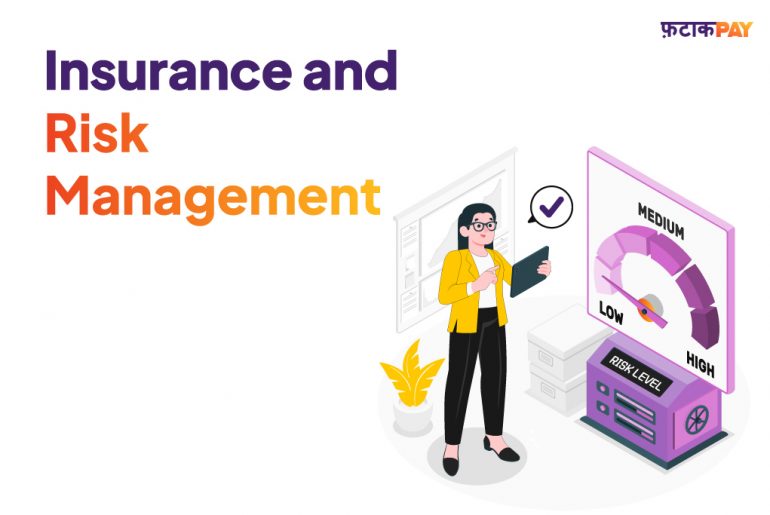In today’s world of uncertainty, insurance and risk management have become crucial pillars of financial stability for everyone. They act as protective shields against the unknown and unpredictable, providing a sense of security and peace of mind. For both you and corporations, they serve as the foundation of financial stability.
In this blog, we will cover the various ideas, real-world applications, and the constantly changing field of insurance and risk management with a thorough analysis of this topic.
Basics of Risk management
1. Understanding Risk
Risk is a universal force in your daily life. It encircles the potential for loss or harm and comes to you in various forms. These forms are categorized into financial risk, operational risk, strategic risk, and more.
If you want to manage the risk effectively, understanding risk is the first step. Financial risk includes uncertainties related to your investments, market fluctuations, and credit. Operational risk is the possibility of losses from internal processes, people, or systems.
Strategic risk encircles the risks associated with your business strategy and its potential impact on your financial performance.
2. The Risk Management Process
The motive of risk management is to recognize, evaluate, reduce, and keep track of potential dangers. This well-thought-out strategy can help you handle uncertainty more effectively.
- Risk Identification: Identifying possible risks in your projects, investments, or operations is the first stage in the risk management process. Having an acute sense of weakness is essential.
- Risk Assessment: When the risk is detected, it’s critical to evaluate its possible consequences and likelihood related to your company. Risks are assessed using both quantitative and qualitative procedures.
- Risk Mitigation: Reduction of risk’s effect and probability is the goal of mitigation techniques. These tactics can take many different forms, such as risk transfer, risk reduction, and risk avoidance.
- Risk Monitoring: Risk monitoring is essential once dangers have been recognized and evaluated and solutions for mitigating them have been implemented. Risks are dynamic and constantly changing; thus, continuous monitoring is necessary.
The Foundation of Insurance
1.The Essence of Insurance
Insurance is a vital instrument for money management since it protects a range of risks. It acts as a safety net by offering financial stability in the event of unexpected situations. Its roots are in the collective resource-sharing customs of ancient societies, which helped members in hard times.
Today, insurance is necessary to ensure that you have the funds required in the event of unforeseen events.
2. Insurance Principles
Several basic principles govern insurance. Among these is the rule of maximum good faith, which demands that insurance contracts be truthful and open.
By not turning a profit, the protection concept guarantees that you receive compensation equal to the magnitude of your losses. It would be best to have a financial stake in the covered person or property for your insurance policy.
A Closer Look at Types of Insurance
1. Life Insurance
A financial tool that safeguards your loved one’s financial future is life insurance. It is available in term, whole-life, and universal life insurance plans, among other types. Term insurance covers you for a set amount of time; whole life and universal life insurance offer you security for the rest of your life together with monetary value.
2. Health Insurance
Health insurance allows for access to high-quality medical care without placing an undue financial burden on your finances. It requires knowledge of concepts like premiums, co-payments, and deductibles. These components are essential in determining how much a health insurance plan will cost and its benefits.
3. Property Insurance
Houses, belongings, and real estate investments are protected by property insurance. It requires awareness of how various insurance policies—which address multiple needs and situations—affect tenants, homeowners, and landlords.
4. Auto Insurance
While driving, having auto insurance offers you comfort. In addition to complete coverage, which guards against events unrelated to collisions, it also contains liability coverage, which covers harm to third parties. Collision coverage also pays for repairs to your insured car.
5. Business Insurance
Maintaining business continuity in the face of unexpected disruptions requires business insurance. It includes liability insurance to protect against debts, business interruption insurance to help with unforeseen expenses, and commercial property insurance to safeguard company assets.
Fusion of Insurance and Risk Management
1. Risk Assessment and Analysis
Various instruments and methods for identifying and assessing risks must be used for effective risk management. One cannot stress how crucial it is to quantify risk.
Quantitative data is vital in allocating resources for risk reduction and evaluating the potential impact of different dangers. Through knowledge and evaluation of threats, you can decide on the best course of action for self-defense.
2. Insurance as a Risk Management Tool
Risk management and insurance work together harmoniously. One of the most essential instruments for controlling and reducing risk is insurance. Achieving the ideal balance between external insurance solutions and self-insurance is crucial.
Self-insurance is putting money aside for possible losses. In contrast, exterior insurance acts as a safety net if something unexpected happens. Effective risk management requires an understanding of this balance.
Trends and Technologies of Insurance and Risk management
1. Insurtech: Intersection of Insurance and Technology
Thanks to technology improvements, the insurance and risk management industries are changing quickly. Combining “insurance” with “technology” is essential to this change. The insurance sector is transforming because of blockchain technology, AI, and data analytics.
They make it possible to identify risks more precisely, expedite procedures, and enhance customer satisfaction. Accessing and managing insurance plans is becoming more straightforward for people and businesses, thanks to digital insurance platforms.
2. Sustainable Risk Management
Environmental, social, and governance (ESG) concerns are becoming increasingly important today. As you face difficulties relating to climate change, social responsibility, and authority issues, sustainable risk management techniques are becoming increasingly important.
Insurers increasingly recognize the importance of sustainable insurance practices, which involve integrating ESG factors into their underwriting and investment decision-making processes. To appropriately handle global concerns, this transition is needed.
Evolution of Insurance and Risk Management
1. Preparing for an Uncertain Future
Every day, new difficulties appear, and the world is characterized by n784ever-ending change and unpredictability. These worldwide issues require adaptation on your part in risk management and insurance. A constantly shifting risk landscape calls for your agility. The techniques and equipment needed to properly manage risks also change with time.
2. Ethical Considerations
Risk management and insurance both have important ethical components. Security and data privacy are critical ethical issues in today’s networked society. It would be best to balance these moral obligations to give customers the best service possible.
Conclusion
Financial security is based on risk management and insurance, which act as a safety net in an unpredictable world. Financial security is based on risk management and insurance, which act as a safety net in an unpredictable world.
Well, if it is a risk related to Credit then you don’t need to worry if you have FatakPay. Because FatakPay is a financial wellness platform providing credit to the masses. It is a quick, transparent and a secure way to manage your day to day needs, without being worried about the risk of losing anything, as it is powered by an RBI-registered NBFC, ensuring the highest level of security.
Your approach to risk management and insurance solutions must adapt to the changing needs of our planet. With the correct information, initiative, and flexibility, you can face uncertainty head-on.
You have uncovered the fundamental ideas, real-world applications, and dynamic environment of this vital field by thoroughly examining insurance and risk management. You can guarantee your financial future in an uncertain world by mastering uncertainty through educated risk management and appropriate insurance.







